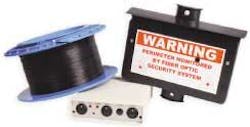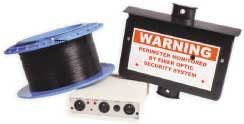For some security applications, fiber is the sensible choice
Long-distance video transmission, intrusion detection prompt use of the optical medium.
Optical fiber is often recognized as the medium that can carry high-rate data traffic over long distances. While it can do that in ways that have been chronicled in this and other publications for years, fiber can also be the medium of choice for many security-based applications.
Specifically, fiber can carry video transmissions great distances, and is often chosen over coaxial cable for surveillance systems that span several acres or even square miles.
Additionally, today some perimeter-protection systems use optical fiber as a central element. In these cases, fiber’s role is not merely to carry a signal from one point to another; the optical signals traveling through the fiber are the basis of the protective system.
Long-distance video
“Most video signals can be sent over coaxial cable about 1,500 feet before they start to degrade,” says Justin Stevens, engineer with Fiber Instrument Sales (www.fisfiber.com), a manufacturer and distributor of products for communications and security applications. That signal degradation leads to a snowy picture, he explains, and a coaxial system requires regeneration under these conditions. “With fiber, the most economical system reaches 2.5 miles without the need for regeneration,” Stevens says.
Fiber cable’s dielectric properties keep it immune from interference sources, which is a practical asset in more ways than one, Stevens points out. “You don’t have to worry about routing complications,” when positioning cameras near electrical sources or other forms of interference, he explains.
In many cases (because few cameras have optical-fiber ports), deploying optical fiber as a surveillance-video infrastructure requires installing equipment that converts the camera-generated signal to an optical signal, then back to a standard video output before connecting to monitors, recorders, or switching equipment.
Panasonic (www. panasonic.com), for example, offers a line of optical-fiber video transmission products that it says are applicable in installations where the distance, bandwidth, or image quality requirements strain the capabilities of standard coaxial transmission. The company says its optical system can transmit video as far as four miles with virtually no loss of image clarity or quality, and without repeaters or amplifiers. Panasonic offers optical transmitters, receivers, and transceivers for that purpose.
American Fibertek (www.americanfibertek.com) also makes equipment that enables video-over-fiber transmission. Its multimode products allow up to 8-kilometer (km) transmission distances, and its singlemode products allow up to 25 km. American Fibertek’s transmitter and receiver products are available in varieties that provide single- or multiple-channel transmission, and can be used with either fixed or pan-tilt-zoom cameras.
The applications for optical-based video transmission are predictable-predominantly sprawling sites where the use of coaxial infrastructure would require multiple repeaters or amplifiers. Also, there are times when interference is significant enough that the multiple layers of shielding around a coaxial conductor still leave it suspect; so, fiber’s zero-interference capability makes it a wise choice.
Perimeter protection
In another security application, optical fiber is not merely the carrier of a signal, but is the central element of the protection provided by that system. Both Fiber Instrument Sales and Fiber SenSys (www.fibersensys.com) offer perimeter-security systems that use optical fiber as the means of intrusion detection.
Fiber Instrument Sales’ Fiber Fence Perimeter Monitoring System debuted in 2002, and the company has since developed several versions with varying distance capabilities and price categories. The system works by passing optical-fiber sensing cable through mechanical tripping devices called Mouse Trips, which are installed at intervals along a fence line. A cut in or tug on the cable triggers the nearest Mouse Trip. Once triggered, the Mouse Trip reduces the flow of light through the optical fiber, and the system’s control unit detects the attenuated flow of light.
“The system includes a headend control unit, available in four models, a fiber-optic sensor, Mouse Trips, and ties that are UV- and weather-resistant,” says Fiber Instrument Sales’ Stevens. The different versions provide various monitoring ranges and different levels of sensitivity to intrusion.
The Mouse Trip is a mechanical enclosure device that detects an event such as a tug or pull along the fiber cable, prompting the system to sound an alarm even when the fiber is not broken. The unit is installed directly on the fence, with a fiber attached inside the enclosure. “All models send light down the fiber and measure it at the other end,” Stevens continues.
Fiber Fence 2000 monitors up to 80 km of perimeter and, unlike other versions, does not require the fiber cable to loop back to the controller. It includes a fully operational optical time-domain reflectometer (OTDR) that identifies and locates breaks in the fiber.
The 1000 model measures the distance to a break (monitoring range of approximately 7 km), and displays the information on the control unit’s face. It is mountable onto a standard 19-inch rack.
Model 100 was designed primarily for small-perimeter applications where the fence area is in full view; the control unit will generate an alarm when the fiber is broken or tugged. And the Fiber Fence 50 monitors up to 10,000 feet of perimeter.
“With Fiber Fence 50 and Fiber Fence 100, when the light level drops an alarm goes off,” says Stevens. “The Fiber Fence 1000 also begins scanning the fiber to find the intrusion location. The scan takes between 15 and 45 seconds.”
The property-protection systems from Fiber SenSys employ a concept similar to that of Fiber Fence. Product names such as Fiber Defender, Fiber-Optic Security Network, and SecurLAN use optical fiber as a means of detecting intrusion. And the components are similar; each system contains an alarm processor unit, fiber-optic sensor cable and connectors, an “intelligent” field panel, and software.
“All three are trademarked names for specific configurations of our products, and they each use a similar technology at the core,” explains Tony Cardo, business development manager for the SecurLAN system. “Fiber Defender refers to fiber-optic intrusion detection on fences, walls, culverts, tunnels, and buried underground. As with all our sensors, we detect movement, vibration, sound, or pressure, enabling highly configurable alarm-event monitoring.”
Card continues, “SecurLAN takes the same technology and applies it to LAN and WAN conduit, where the physical layer of an IT network is protected from physical tapping, tampering, and splitting. Unlike many software-based intrusion-detection systems and intrusion-prevention systems, where cyber-attack is the threat and encryption and firewalls are at the core of the solution, we protect the physical conduit.”
Fiber-Optic Security Network, a Fiber SenSys system introduced in 1996, is a custom configuration of a proprietary unidirectional single-ring optical network used for connecting the company’s alarm-processing units. It accommodates a variety of sensor and monitoring systems.
Universal appeal
Where are fiber-based security systems most popular? Everywhere, according to system manufacturers. “With several military and Department of Defense certifications in place, we find significant interest in our products from this group,” says Fiber SenSys’ Cardo.
“This leads us to relationships with many systems integrators bidding GSA [General Services Administration] contracts and other perimeter-security integrators,” Cardo continues. “Our technology allows remote monitoring of large secured locations, but there really is no job too small for us.”
Fiber Instrument Sales’ Stevens echoes that sentiment. “Our customer base is a fairly large cross-section. Fiber Fence secures everything from a small cage containing radioactive equipment to an automobile-manufacturing plant with 6.5 miles of perimeter and a 350×100-foot unmanned electrical substation.
That electrical substation, Stevens points out, also includes a closed-circuit television system that is tied into the Fiber Fence alarm panel. A trip of the system will turn on the CCTV system to allow visual monitoring from a remote location.
Fiber SenSys’ Cardo notes, “With the new business unit of SecurLAN, the system has universal appeal where physical protection of fences, walls, culverts, tunnels, and buried applications is expanded with the ability to protect LAN and WAN data conduit. So, so we can also see applications for water pipes and fuel-distribution pipes.”
While optical fiber reaches beyond voice and data communications applications to serve as a robust medium for security systems, some of those security systems, poetically, aim to protect the physical infrastructure of LAN systems.
PATRICK McLAUGHLIN is chief editor of Cabling Installation & Maintenance.

